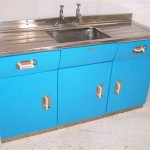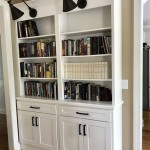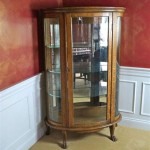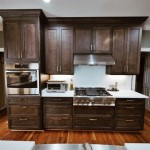Knob Position on Kitchen Cabinets: A Comprehensive Guide
The placement of knobs on kitchen cabinets may seem like a minor detail. However, the position of these hardware elements significantly impacts the overall aesthetic, functionality, and ergonomics of a kitchen. Strategically placed knobs contribute to the visual balance of the cabinetry, facilitate ease of use, and can even influence the perceived style of the kitchen design. This article provides a comprehensive guide to understanding the optimal positioning of knobs on various kitchen cabinet doors and drawers.
Choosing the right knob position requires careful consideration of several factors. This includes the style of the cabinet (e.g., Shaker, slab, raised panel), the size of the cabinet (both doors and drawers), and the overall design scheme of the kitchen. There is no single "right" answer for every situation; rather, a set of generally accepted guidelines and principles can be adapted to suit specific needs and preferences. Attention to detail in knob placement can subtly elevate the entire kitchen space, transforming it from merely functional to thoughtfully designed.
Key Point 1: Standard Guidelines for Door Knob Placement
For cabinet doors, the most common placement for knobs is in the lower corner of the door for upper cabinets and the upper corner of the door for lower cabinets, on the side opposite the hinges. This placement typically involves positioning the knob 2 to 3 inches from both the corner edge and the bottom or top edge of the door. This provides a visually balanced and ergonomically comfortable point of access for opening and closing the cabinet.
Consistency is key, especially within a set of visually matching cabinets. Maintaining a uniform distance from the corner edge and the top or bottom edge contributes to the overall harmony of the kitchen design. Deviations from this standard, while sometimes necessary to suit unique cabinet configurations, should be carefully considered to avoid disrupting the visual flow of the cabinetry.
Another consideration is the swing direction of the door. The knob should always be positioned on the side of the door that allows for the most natural and comfortable opening motion. Placing the knob on the hinge side would necessitate reaching across the door, which is less convenient and potentially awkward. Therefore, always consider which hand users will predominately use to access the cabinet when determining the knob's location.
For taller or wider upper cabinets, a single knob may not be sufficient. In these cases, designers may opt for two knobs, equally spaced along the vertical axis of the door. This provides greater leverage and stability when opening and closing the cabinet, particularly if the cabinet is heavily loaded. The precise spacing of the knobs will depend on the overall size and proportions of the door, but the goal is to create a balanced and visually appealing arrangement.
When dealing with cabinets above appliances, such as a microwave or oven, knob placement needs to factor in accessibility. Ensuring sufficient clearance between the appliance and the knob is crucial for comfortable operation. The knob should be positioned in a way that allows users to easily grip and turn it without bumping into the appliance or straining their wrist.
Key Point 2: Optimal Placement for Drawer Knobs
The placement of knobs on drawers differs slightly from doors, primarily depending on the size and style of the drawer. For standard-sized drawers (typically those less than 24 inches wide), a single knob positioned in the center of the drawer front is the most common and visually appealing choice. This creates a balanced and symmetrical look that complements most kitchen designs.
Finding the true center of the drawer front is crucial. Precise measurements are essential to ensure that the knob is perfectly aligned. Even a slight deviation from the center can be noticeable and detract from the overall aesthetic. A simple measuring tape and a pencil are all that are needed to accurately mark the center point.
For wider drawers (those exceeding 24 inches in width), a single knob may not provide sufficient leverage for smooth opening and closing. In these cases, two knobs are generally recommended. The placement of these two knobs should be symmetrical, with each knob equidistant from the center of the drawer. A common approach is to position each knob one-third of the way in from the outer edge of the drawer front.
The distance between the two knobs on a wide drawer is another important consideration. Too close together, and they will not provide sufficient leverage. Too far apart, and they may appear disproportionate and visually unbalanced. Experimentation with different spacings may be necessary to achieve the optimal balance between functionality and aesthetics. A general rule of thumb is to maintain a distance of at least 6 inches between the two knobs.
Similarly, for tall drawers (often used for pots and pans), considerations should be given to the drawer's height. In these situations, you may want to consider a more ergonomic placement to aid in pulling the drawer open. This can be done by placing the knobs in the upper center of the drawer which can help ensure that the weight of the drawer doesn't affect the user's ability to open the drawer. It is critical to consider accessibility for the user as well as the drawer's specific use when deciding on the height placement of knobs.
Key Point 3: Style Considerations and Exceptions
While the standard guidelines provide a solid foundation, stylistic preferences and unique cabinet configurations may warrant deviations. For example, in kitchens with a decidedly modern aesthetic, designers may opt for a more minimalist approach, positioning knobs closer to the edge of the door or drawer to create a clean and uncluttered look.
Shaker-style cabinets, known for their simple and clean lines, often benefit from knobs placed slightly higher or lower than the standard position to accentuate the frame detail. The exact placement will depend on the specific proportions of the Shaker cabinet door, but the goal is to create a harmonious relationship between the hardware and the surrounding frame.
For slab-front cabinets, which lack any decorative molding or framing, the placement of the knob becomes even more critical. Since there are no visual cues to guide the eye, the position of the knob will have a greater impact on the overall balance of the cabinet. Experimentation with different placements is often necessary to find the most aesthetically pleasing solution.
In kitchens with a more traditional or ornate aesthetic, larger and more decorative knobs may be used. These knobs often benefit from being positioned slightly closer to the center of the door or drawer to better showcase their embellishments. The placement should also take into account the weight and balance of the knob, ensuring that it is securely mounted and does not cause the door or drawer to sag.
The overall kitchen design scheme should also influence the choice of knob position. A kitchen with strong horizontal lines may benefit from knobs that are aligned along a horizontal axis, while a kitchen with a more vertical emphasis may call for knobs that are positioned along a vertical axis. Considering these design principles helps create a cohesive and harmonious kitchen space.
Ultimately, the placement of knobs on kitchen cabinets is a subjective decision that should be based on a combination of practical considerations, aesthetic preferences, and the overall design scheme of the kitchen. By understanding the standard guidelines and being willing to experiment with different placements, renovators and designers can create a kitchen that is both functional and visually appealing.
Beyond the aesthetic considerations, practical limitations may also influence knob placement. For example, the internal construction of the cabinet door or drawer may dictate the available mounting points. It is essential to inspect the cabinet construction carefully before drilling any holes to ensure that the knob can be securely attached. Choosing high-quality hardware is also advisable as cheaper knobs often have poor construction which can lead to stripped threads in the knob or in the screw. Good quality knobs will provide years of reliable service.
When replacing existing knobs, it is often easiest to utilize the existing holes. This eliminates the need for additional drilling and patching. However, if the existing holes are not in the ideal location, it may be worth considering filling them and drilling new ones. This will require patching the old holes with wood filler, sanding them smooth, and then painting or staining them to match the surrounding cabinet finish. While it can be time-consuming, this effort can significantly improve the overall look of the kitchen.
Finally, before making any permanent decisions, it is always a good idea to test out different knob placements using temporary adhesives, such as painter’s tape or removable putty. This allows the user to visualize the final result and make any necessary adjustments before drilling any holes. It also provides an opportunity to assess the ergonomics of the knob placement and ensure that it is comfortable for all users.

A Simple Guide For Ideal Cabinet Knob Placement

Where To Place Cabinet Hardware Emtek Living Blog

Cabinet Hardware Placement Guide

Easy Cabinet Hardware Placement Guide Bloom And Babe

Design 101 Cabinet Hardware Placement Lark Linen

Kitchen Cabinets Knob Placement Guide

How To Place Cabinet Knobs Pulls

Learn How To Place Kitchen Cabinet Knobs And Pulls Cliqstudios

Design 101 Cabinet Hardware Placement Lark Linen

The Ultimate Guide For Cabinet Hardware Placement And Sizing
Related Posts








